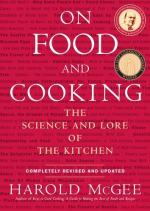
|
| Name: _________________________ | Period: ___________________ |
This test consists of 15 multiple choice questions and 5 short answer questions.
Multiple Choice Questions
1. Which of the following is a fermented dairy product?
(a) Cheese.
(b) Single cream.
(c) Milk.
(d) Buttermilk.
2. What does heat treatment kill in the milk?
(a) Pathogenic and spoilage microbes.
(b) Polar and Garang microbes.
(c) Geriatric and Seething microbes.
(d) Genetic and bulbous microbes.
3. What curdles the milk to make cheese?
(a) Rennet enzymes.
(b) Omega enzymes.
(c) Bennet enzymes.
(d) Wort enzymes.
4. What kind of vitamin do fish and shellfish contain?
(a) Vitamin A.
(b) Vitamin B.
(c) Vitamin C.
(d) Vitamin D.
5. From what kind of crystals is ice cream made?
(a) Cream.
(b) Salt.
(c) Sugar.
(d) Ice.
6. What should one always do to vegetables before eating them?
(a) Wash them.
(b) Freeze them.
(c) Par boil them.
(d) Peel them.
7. What kind of cooking does oven roasting ensure?
(a) Tender cooking.
(b) Half cooking.
(c) Anti bacteria cooking.
(d) Even cooking.
8. What are endives often mixed with to reduce their bitterness?
(a) Salt.
(b) Pepper.
(c) Tobacco.
(d) Sugar.
9. Which of the following is an example of a starchy tuber?
(a) A potato.
(b) An egg plant.
(c) A grape fruit.
(d) A tomato.
10. What did Louis Pasteur invent in the 1860s?
(a) Heat treatment.
(b) Pasterised treatment.
(c) Whipping treatment.
(d) Skimming treatment.
11. What is egg made from?
(a) A living germ cell.
(b) A foetus.
(c) Bacteria.
(d) Sugar and salt.
12. What creates buttermilk?
(a) Butter mixed in with milk.
(b) Whipped cream mixed with milk.
(c) The watery portion of cream.
(d) Slighty sweetened melted butter.
13. What is the name of the bacteria in milk?
(a) Coccoonus.
(b) Hembrane.
(c) Lactococcus.
(d) Lictineous.
14. What country do poke and lomi dishes originate from?
(a) China.
(b) Hawaii.
(c) Gibraltor.
(d) Bermuda.
15. Why are tomatoes generally considered a fruit?
(a) They have low sugar content.
(b) They have high salt content.
(c) They have are savoury product.
(d) They have the coloring of a vegetable.
Short Answer Questions
1. Why does the author think one should grill thin meat?
2. What have people practiced with meat for over 4000 years?
3. What is the most frequently used of the unfermented dairy products?
4. What kind of food does the second chapter examine?
5. Which of the following is a method of drying fruit?
|
This section contains 359 words (approx. 2 pages at 300 words per page) |

|




